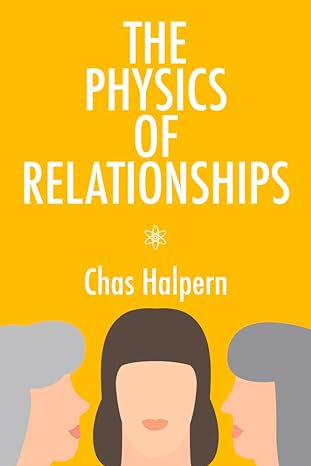The Physics of Relationships
- Rose Auburn

- Apr 9, 2024
- 3 min read
Updated: Nov 17
by Chas Halpern
Rating: ****

The Physics of Relationships is a lovely novel that I found a light, easy read although it explores subjects far from light or easy. Halpern examines issues including loss, relationship dynamics, and forgiveness through the reflections of Lexi, a recently widowed sixty-three-year-old.
Using the immediacy of the first-person perspective, Lexi shares her thoughts, opinions, and internal conflicts as she navigates unexpected lodgers, strange proposals, adult children, an ex-husband, and the aging process.
All these mini-dramas are set against the backdrop of Lexi’s gentle mourning, not just for her second husband, Lawrence, but also for the life they shared, leading to a feeling of existential lack.
Lexi’s contemplations are delicately woven with subtle threads of Zen wisdom, mild philosophical musings, and pithy observations for which she immediately chastises herself.
From the opening chapter, Lexi draws the reader in. Sharply intelligent but socially hesitant, she is prone to over-thinking. She has a wicked little seam of wry humor disguised as naivety and is endearingly vulnerable as she cogitates life sans Lawrence.
Halpern pitches Lexi perfectly without resorting to cliché or over-emotional embroidery. Her voice is wonderfully convincing, full of warm sensitivity and female intimacy. Notwithstanding, there are definite shards of buried autobiography from the author and these odd subjective glints add personal depth and nuance to an already beautifully observed protagonist.
However, she can be maddeningly frustrating. Although seemingly self-aware, she either deceives herself or the reader when she considers, in chapter twenty-one, to be a “master manipulator”.
Although it could be leveled that her often passive, slightly indecisive stance tends to yield her exactly what she wants, even if it does make the reader occasionally long to shake her.
Her best friend, Amy, certainly is manipulative. In addition to being a pretentious, toxic narcissist but a brilliantly vibrant character. I loathed Amy (in a positive way) which is a credit to Halpern’s strong, realistic depiction of her.
The only element that seemed misplaced given their decades of platonic friendship was the bed-sharing between her and Lexi which had fleeting Sapphic undertones instigated by Amy. I wondered at her motivations for this and the later “proposal” she places before Lexi.
I was also undecided regarding Danielle, Lexi’s unforeseen tenant, not quite subscribing to the poor waif view that Lexi possessed, especially given a couple of flashes of Danielle’s temper. I found her intriguing and the vehemence that Tasha, Lexi’s daughter, harbors toward her for the majority of the novel was revealing.
Indeed, Lexi has two adult children, Tasha (also known as Sage) and Brandon from her first husband, Greg. Brandon is absent for most of the novel. When he appears, Halpern nails his individuality and it’s a shame he doesn’t surface earlier.
Tasha sometimes resembles a stroppy, volatile teenager, although she is in her early thirties. Nonetheless, Halpern does an excellent job of rendering the challenges and contrasts of Mother/Daughter relationships set against a contemporary backdrop of gender and sexual fluidity.
When Lexi allows her ex-husband, Greg back into her life, albeit tentatively, things could have become a little syrupy and convenient. Still, Halpern is careful to avoid this and takes a considered, ambiguous route which is the more plausible and, consequently, satisfying.
The Physics of Relationships is smart, insightful, and uplifting. Well worth a read.
Buy from:




Comments